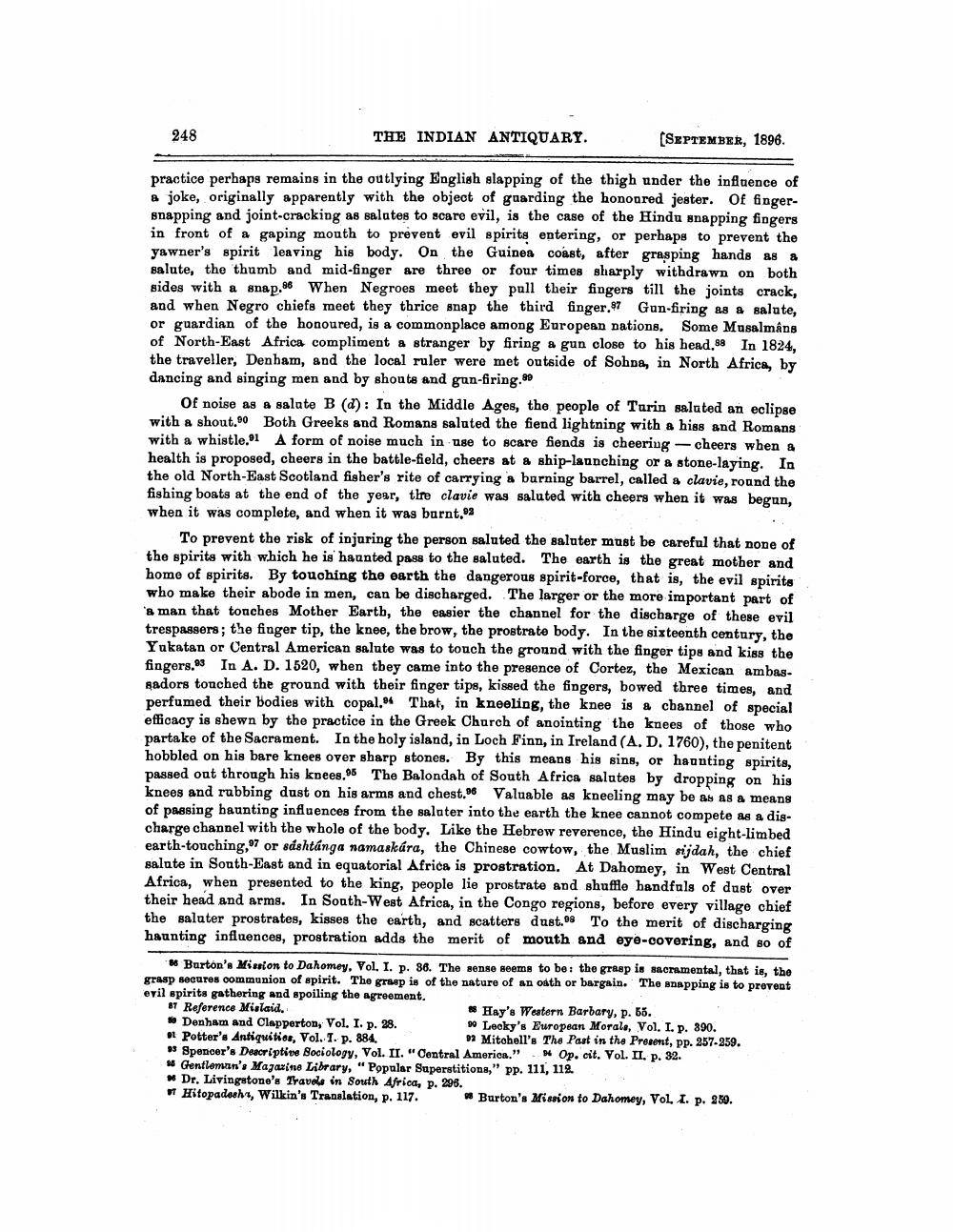________________
248
THE INDIAN ANTIQUARY.
(SEPTEMBER, 1896.
practice perhaps remains in the outlying English slapping of the thigh under the influence of a joke, originally apparently with the object of guarding the honoured jester. Of fingersnapping and joint-cracking as salates to scare evil, is the case of the Hindu snapping fingers in front of a gaping mouth to prevent evil spirits entering, or perhaps to prevent the yawner's spirit leaving his body. On the Guinea coast, after grasping hands as & salute, the thumb and mid-finger are three or four times sharply withdrawn on both sides with a snap.86 When Negroes meet they pull their fingers till the joints crack, and when Negro chiefs meet they thrice snap the third finger,37 Gun-firing as a salute, or guardian of the honoured, is a commonplace among European nations. Some Musalmans of North-East Africa compliment a stranger by firing a gun close to his head.88 In 1824, the traveller, Denham, and the local ruler were met outside of Sohna, in North Africa, by dancing and singing men and by shouts and gun-firing.*
Of noise as a salate B (d): In the Middle Ages, the people of Turin salated an eclipse with a shout. Both Greeks and Romans salated the fiend lightning with a hiss and Romans with a whistle. A form of noise much in use to scare fiends is cheering - cheers when a health is proposed, cheers in the battle-field, cheers at a ship-launching or a stone-laying. In the old North-East Scotland fisher's rite of carrying a burning barrel, called a clavie, round the fishing boats at the end of the year, tire clavie was saluted with cheers when it was begun, when it was complete, and when it was burnt,
To prevent the risk of injuring the person saluted the saluter must be careful that none of the spirits with which he is haunted pass to the saluted. The earth is the great mother and home of spirits. By touching the earth the dangerous spirit-force, that is, the evil spirits who make their abode in men, can be discharged. The larger or the more important part of a man that touches Mother Earth, the easier the channel for the discharge of these evil trespassers; the finger tip, the knee, the brow, the prostrate body. In the sixteenth century, the Yukatan or Central American salute was to touch the ground with the finger tips and kiss the fingers. In A. D. 1520, when they came into the presence of Cortez, the Mexican ambassadors touched the ground with their finger tips, kissed the fingers, bowed three times, and perfumed their bodies with copal.” That, in kneeling, the knee is a channel of special efficacy is shewn by the practice in the Greek Church of anointing the knees of those who partake of the Sacrament. In the holy island, in Loch Finn, in Ireland (A.D. 1760), the penitent hobbled on his bare knees over sharp stones. By this means his sins, or haunting spirits, passed out through his knees.95 The Balondah of South Africa salates by dropping on his knees and rubbing dust on his arms and chest. Valuable as kneeling may be as as a means of passing baunting influences from the salater into the earth the knee cannot compete as a discharge channel with the whole of the body. Like the Hebrew reverence, the Hindu eight-limbed earth-touching, 7 or sdshtanga namaskára, the Chinese cowtow, the Muslim sijdah, the chief salute in South-East and in equatorial Africa is prostration. At Dahomey, in West Central Africa, when presented to the king, people lie prostrate and shuffle bandfals of dust over their head and arms. In South-West Africa, in the Congo regions, before every village chief the saluter prostrates, kisses the earth, and scatters dust. To the merit of discharging haunting influences, prostration adds the merit of mouth and eye-covering, and so of
* Burton's Minion to Dahomey. Vol. I. p. 86. The sense seems to be the griep is sacramental, that is, the grasp secures communion of spirit. The groep is of the nature of an oath or bargain. The snapping is to prevent evil spirits gathering and spoiling the agreement. 87 Reference Mislaid.
* Hay's Western Barbary, p. 58. Denham and Clapporton, Vol. I. p. 28.
90 Lecky's European Morale, Vol. I. p. 390. 1 Potter's Antiquities, Vol. I. p. 884.
92 Mitchell's The Past in the Present, pp. 257-359. * Spencer's Descriptive Bociology, Vol. II. "Central America." # Op. cit. Yol. II. p. 32. # Gentleman's Magazine Library, "Popular Superstitions," pp. 111, 112 # Dr. Livingstone's Travels in South Africa, p. 298. Hitopadesh, Wilkin's Translation, p. 117.
Burton's Mission to Dahomey, Vol. I. p. 250.




